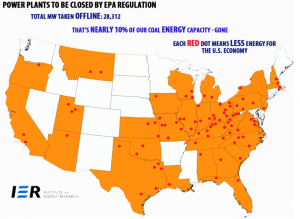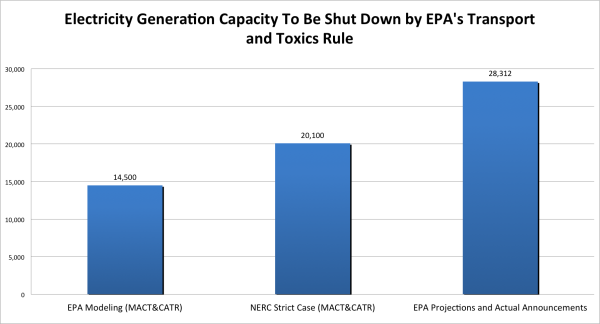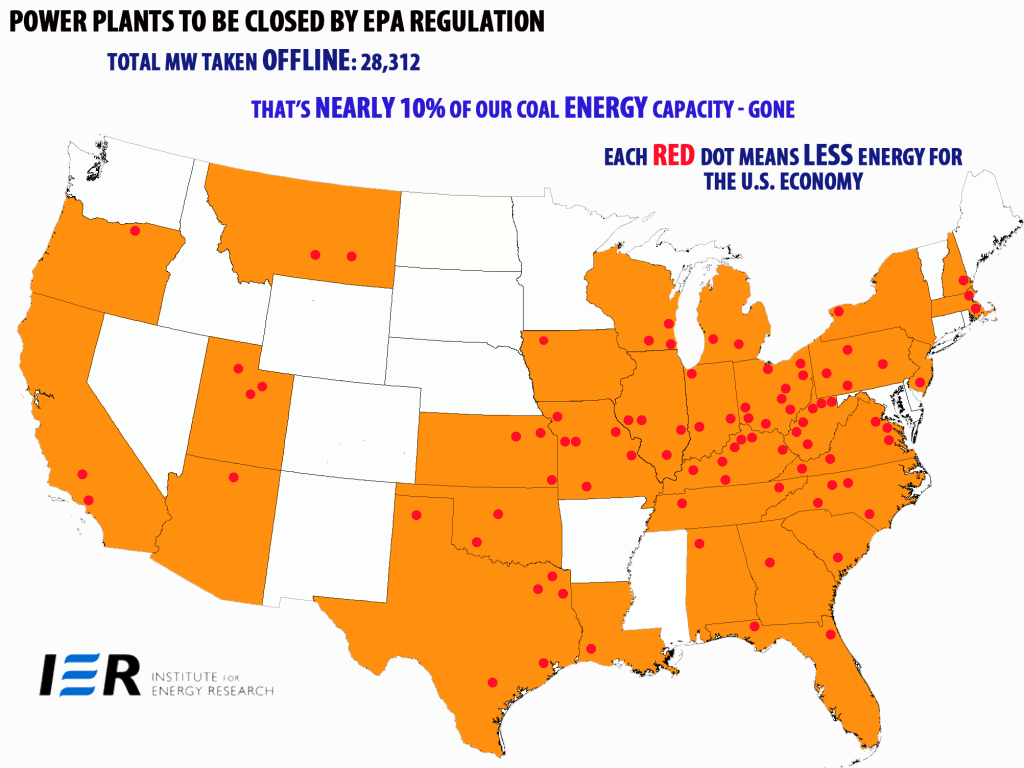“So if somebody wants to build a coal-fired plant they can. It’s just that it will bankrupt them…”
– Barack Obama speaking to San Francisco Chronicle, January 2008
In the months since we released this report, electricity producers have announced another 6 GW of impending plant closures as a result of EPA’s upcoming regulations. To see the updated information, click here for the updated report.
![]() Download the Updated Report as a PDF
Download the Updated Report as a PDF

October 7, 2012
The United States has the world’s largest coal resources. In fact we have 50 percent more coal than Russia, the country with the next largest reserves. But coal use in the United States is under assault.
Before becoming President, Barack Obama promised to bankrupt coal companies. As President, he has tried various strategies to force Americans to use less coal. After failing to pass a national energy tax (cap-and-trade), the President vowed to continue his attack on coal stating, there is “more than one way to skin a cat.”
Currently, EPA is leading the Obama administration’s assault on coal with a number of new regulations. Two of the most important are the “transport rule” and the “toxics rule” (Utility MACT). Combined, these regulations will systematically reduce access to affordable and reliable energy. According to our report:
- EPA Regulations Will Close At Least 28 GW of Generating Capacity
EPA modeling and power-plant operator announcements show that EPA regulations will close at least 28 gigawatts (GW) of American generating capacity, the equivalent of closing every power plant in the state of North Carolina or Indiana. Also, 28 GW is 8.9 percent of our total coal generating capacity.
- Current Retirements Almost Twice As High As EPA Predicted
EPA’s power plant-level modeling projected that Agency regulations would close 14.5 GW of generating capacity. That number rises to 28 GW when including additional announced retirements related to EPA rules, almost twice the amount EPA projected. Moreover, this number will grow as plant operators continue to release their EPA compliance plans.
- Announced and Projected Retirements Higher Than Worst Case Scenarios
Analysis by the North American Electric Reliability Corporation (NERC), the entity in charge of grid reliability, projected that EPA’s Transport Rule and Toxics Rule would close 20 GW of generating capacity. This list indicates that at least 28 GW will retire. EPA’s Transport Rule and Toxics Rule push U.S. energy security past the NERC worst case scenario.
- EPA’s New Regulations Will Hit States Trying To Get Back On Their Feet
Current announcements and EPA projections indicate that EPA regulations have a dramatic impact on states reeling from economic hardship.
- Ohio: 2,894 MW retired, 8.6% of state total generating capacity.
- West Virginia: 2,448 MW retired, 14% of state total generating capacity.
- Indiana: 2,168 MW retired, 7.5% of state total generating capacity.
- Tennessee: 1,376 MW retired, 6.2% of state total generating capacity.
- Missouri: 1,325 MW retired, 6.3% of state total generating capacity.
- Wisconsin: 902 MW retired, 5% of state total generating capacity.
Download the spreadsheet of power plants by clicking here: Announced and EPA Projected Power Plant Retirements
[table id=45 /]
Notes:1. All retirements announced by plant owners result from EPA regulation. In each such case, the citation included directly identifies EPA regulations as the sole or main reason for the power plant’s retirement.
2. Plant closures attributed to EPA modeling only include those plants that EPA projects to close as a result of EPA regulations. “Toxics Rule” results were found by removing plants listed on the Toxics Rule “IPM Parsed File – Base Case” (EPA-HQ-OAR-2009-0234-3032) from the “IPM Parsed File – Policy Case” (EPA-HQ-OAR-2009-0234-3033). “Transport Rule” results were found by removing plants listed on “TR Base Case Final” from the “TR Remedy Final” (both files available at: http://www.epa.gov/airmarkets/progsregs/epa-ipm/transport.html).
3. According to the EPA, the Toxics Rule base case includes the Transport Rule. Thus, theoretically, both the Toxics Rule Policy Case and Transport Rule Remedy Case (when controlled for their respective base cases) should not both independently identify closure of the same plant. Nevertheless, the list shows a 2 GW overlap between the two rules. This is, presumably, due to variance in the modeling platforms EPA utilized for both rules.
Power Plant Retirement List Background Information
Methodology
List Sources
This list is derived from three sources: (1) EPA’s parsed modeling files, which identify the power-plant units that EPA models say will close as a result of either the Clean Air Transport Rule (Transport Rule) or Utility MACT (Toxics Rule); (2) news releases or press stories where a power-plant operator says a unit will or is likely to close due to EPA regulations; and (3) filings with state public utility commissions where a power-plant operator says a unit will or is likely to close due to EPA regulations. All sources are publically available information.
EPA Parsed Files
Process to Identify Units Closed by EPA Regulation
Individual power-plants often have multiple boilers, called “units,” that generate electricity. EPA, in addition to overall modeling, models the impact that the Agency believes its regulations will have on each unit, at each power-plant in America. EPA lists these results in “parsed files.” When producing parsed files for a regulation, EPA will first create a business-as-usual “base” case parsed file where the Agency details what it believes will happen absent EPA’s new regulation. Next, EPA creates a “policy” or “remedy” case parsed file showing how EPA believes plants will respond to a regulation. Thus, one can find the difference between these two cases, and figure out the impact EPA believes a regulation will have, by comparing the policy/remedy case parsed file to the base case parsed file. As such, the following steps were taken so that the list would only include those units EPA said would retire as a result of the Transport Rule and Toxics Rule:
For the Transport Rule, data from the parsed files for the Transport Rule’s base case and remedy case were put on a single spreadsheet. The combined results were organized by plant name. Each plant listed in both the base case and remedy case was removed. Thus, the resulting list only shows those plants that EPA believes will close because of the Transport Rule.
For the Toxics Rule, data from the parsed files for the Toxics Rule’s base case and policy case were put on a single spreadsheet. The combined results were organized by plant name. Each plant listed in both the base case and policy case was removed. Thus, the resulting list only shows those plants that EPA believes will close because of the Toxics Rule.
The resulting base case-free Transport Rule list and Toxics Rule list were then put on a single spreadsheet. The combined results were organized by plant name. In each instance where the Transport Rule and the Toxics Rule independently said the same plant would retire, one of the entries was deleted so as to not double-count it. The citation was modified to attribute the unit closure to both the Transport Rule and Toxics Rule.
Transport Rule Parsed File
The parsed file for the Transport Rule is based on EPA’s proposed Clean Air Transport Rule and not the final Cross State Air Pollution Rule (CSAPR). EPA has not yet made the CSAPR parsed files available to the public. However, given that the final CSAPR is more stringent than the rule’s proposed version, it is likely that CSAPR’s parsed file will show more unit closures than the parsed file used on this list.
Power-plant Owner Public Announcements
Ensuring that Retirements are Result of EPA Regulation
All retirements announced by plant owners in news releases or through public filings on this list were due to EPA regulation. In each such case, the source cited directly identifies EPA regulations as the sole or main reason for the power plant’s retirement.
Avoiding Double-Counting
If a unit was identified to close by both EPA parsed files and public announcements, then the duplicate entry was released. The units citation was modified to indicate that both EPA and public announcements slated the unit for retirement.
Frequently Asked Questions
Why is this list’s total retired capacity higher than EPA’s total?
The total retired capacity for this list is higher than EPA’s total because this list includes EPA’s projected unit retirements and unit retirements announced by power-plant operators. No unit cited by both sources was double counted.
Does this list include plants that will close even without the Transport Rule or Toxics Rule?
No. The parsed file results used in this list do not include business-as-usual base case results. In other words, if EPA modeled a unit to close even if the Transport Rule or Toxics Rule were not implemented, then that unit was not included.
EPA says only 9.9 GW will close, so why are these numbers higher?
The 9.9 GW retired coal-plant capacity figure is from the EPA Regulatory Impact Analysis (RIA) for the Toxics Rule alone. The Transport Rule RIA projects an additional 4.8 GW of coal-plant capacity to retire due to the Transport Rule. When combined, the RIA’s project 13.8 GW of coal-plant capacity to retire due to the Toxics Rule and Transport Rule. As noted above, additional plant retirements are due to actually announced retirements.
Why do EPA’s RIAs say the Transport and Toxics Rule will retire 13.8 GW of coal-capacity, while EPA’s parsed files say the two rules will retire 14.5 GW?
EPA’s overall modeling runs and parsed model use slightly different methods. Thus, the totals for the final results are slightly different, though very similar. The difference between the two totals is only .8 GW.
When a power-plant operator announces that it is closing a certain unit, how do you know that is because of EPA regulations?
In each case where a retirement is attributed to public announcements, the cited source material lists EPA regulations as the sole or main reason for the plant’s retirement.
Some groups have said EPA regulations will retire 60 – 80 GW of coal-fired generation, but this list only shows 28 GW. Does this mean those projections are wrong?
No. If anything this list gives more credibility to those higher retirement projections. This list is very conservative; it merely shows what units EPA says its regulations will close, plus specific units that plant-operators have said will close because of EPA regulations. Those analyses that show higher power-plant retirements than this list lay out what the final overall impact of EPA’s regulation will be. On the other hand, this list focuses just on the currently disclosed impact. Plant-operators generally announce retirements only when required to by public filings. Thus, this list will likely grow far higher. However, because this list already finds twice as many retirements as EPA projected, the Agency’s claim that its regulations will have minimal impact on electric generation are clearly incorrect.
EPA has said that other projections showing a high coal generation retirements were based on incorrect assumptions. Is that the case for this list?
No. The only modeling in this list is from EPA. Thus, any mistaken assumption would be EPA’s mistaken assumption. Otherwise, the remaining data is from actual public announcements detailing the imminent or highly possible closure of specific units at specific power-plants.
The North American Electric Reliability Corporation (NERC) projected that most power-plants will retire because of EPA 316(b) cooling tower regulations. Does this list account for the fact that EPA has since indicated it will pursue less stringent 316(b) regulations?
This list only includes the parsed files for EPA’s Transport Rule and Toxics Rule modeling. EPA’s modeling for the 316(b) is not included. Public unit retirement announcements largely cited the Transport Rule and Toxics Rule as causing a unit to retire; there is little discussion of 316(b) regulations. This is likely due to the fact that EPA ultimately chose to pursue less stringent cooling tower rules than the Agency originally insinuated. Regardless, all of the publically announced plant retirements listed are retiring due to EPA regulations.
This list compares its total numbers to NERC’s worst case analysis. Does that include NERC’s analysis of 316(b) regulations?
No. The NERC analysis was broken down between the Transport Rule, the Toxics Rule and 316(b) regulations. The chart compares the list only to the NERC Transport Rule and Toxic Rule “strict,” or worst case, scenarios.





